It has officially been almost a month since I crossed the finish line of the 2024 NYC Marathon, and I genuinely cannot wait to do it again in 2025. Most of my friends have been patiently waiting for me to write about the race, but I had been putting it off because every time I revisit the experience, I’m overwhelmed with an insatiable yearning to be back in the city — a strange feeling that is in direct conflict with my equally overwhelming desperate desire to be home for more than a week straight (for the first time in 2024) before years’ end.
But, hey, better late than never, right?
Marathons always feel like such an insurmountable endeavor when they’re in front of me, but the minute the race is over, I find myself subconsciously trying to retrace my steps because I can’t for the life of me figure out how I already wound up on this side of it. I spent months envisioning this race as a mile marker where, upon reaching it, I could grant myself permission to take the time needed to process everything that has happened this year, to take a real break (mentally and physically). But race day came and went at lightning speed, and I’ve somehow continued to barrel forward without losing (too much) momentum.
However, I learned last week that I have a stress fracture in my foot, an injury that should likely be interpreted as a sign that I would benefit from slowing down a bit after this whirlwind turmoil-filled year, but I’ve never been good at that. The only time I’ve ever been slow is when I’m running, so once my foot is healed I’ll get right back to it — I’ve already got my sights on the 2025 Berlin and NYC Marathons for next fall.1
The expected post-marathon blues have hit in full force, exacerbated by my temporary running restrictions, so I feel that it’s finally time for me to revisit my marathon experience before my fragmented memories evaporate into fleeting wisps…
About the Race
The 2024 NYC Marathon broke the world record for largest marathon, with over 55,600 runners taking over the city streets. Most races require some logistical planning for runners, but especially races this large. In the months leading up to the race, runners have to strategize lodging, transportation, training, fueling and hydration, breaking in shoes, pacing, coordinating spectator meeting spots, and probably a few other things that are currently slipping my mind. I also spent a lot of time familiarizing myself with what to expect along the course, reading accounts from other runners about the best parts of the experience and where they struggled most.
The race starts on the Verrazzano-Narrows Bridge, the highway that links Staten Island to Brooklyn. All vehicles need to cross the bridge before the MTA shuts it down around 7:30 am, so despite having an 11:30 start time, Amanda and I were on the bus by 6:30.2
Alternatively, we could have taken the Staten Island Ferry, but there are a few reasons why we opted into the former:
There are so many people on the Ferry that we’d likely have to stand the whole time. We were already going to be on our feet for about 6 hours that day, and figured it would be wise to give our legs a break.
Once you get to Staten Island by ferry, you have to wait in line for a bus to take you to the start village. Instead, our bus took us straight from the NY Public Library on 5th Avenue to the start village, which saved us well over an hour, probably closer to two, of transportation time.
It’s almost impossible to predict how long it will take to get on the bus after the ferry, especially later in the morning after the race has already started. I know several people who almost missed their starting wave because of these kinds of timing snafus.

Each wave of runners (of which there are five) has three different group colors that dictate where you run. Blue runs the top deck on the right side of the Verrazzano-Narrows Bridge, Orange starts on the left side of the top deck, and Pink starts on the bottom deck of the bridge. The Pink group runs a slightly different course before joining Blue runners around mile 3.2. When running through Brooklyn, Blue (and eventually Pink) have to stay on the right side of the road while Orange remains on the left, until all colors converge around mile 8.
The start village for this race is also organized by these color groupings to make it easier for each wave’s 11,000+ runners to get to their starting positions. However, runners are free to roam in search of porta potties that still — by some miracle — have toilet paper,3 and there are other communal spaces spread throughout the village to explore (a quiet zone tent directly next to a set of speakers blasting pop music; a non-denominational place of worship; a few VIP and charity tents that only special runners can access; a spot to snag some bagels, coffee, and a beanie from Dunkin’, etc.).

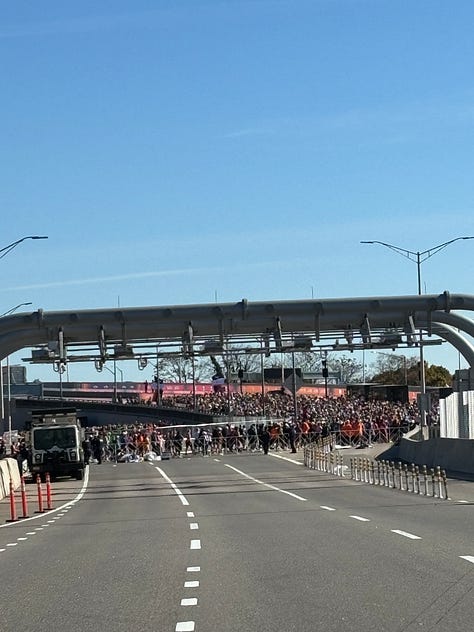
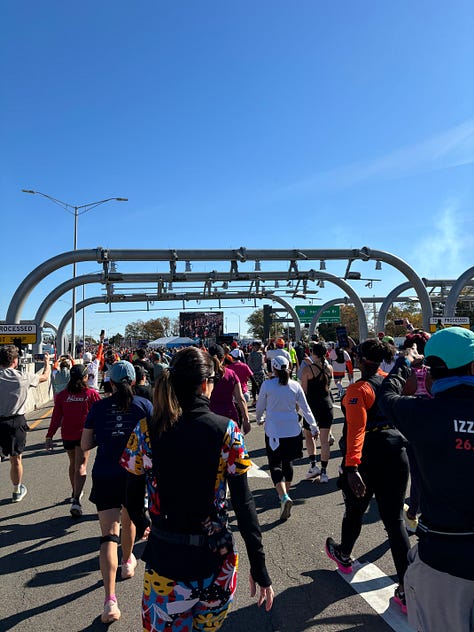
The Course
One piece of advice long-distance runners consistently share with first-timers is to make sure not to start too fast, because adrenaline will encourage you to sprint, which inevitably leads to a quick crash and a rough slog through the remaining miles. The good news for runners interested in the NYC Marathon is that, despite the efforts made to spread runners out amongst three different starting areas, it’s damn near impossible to start too fast with this many runners on such a narrow course.
Staten Island (Borough 1/5)
At the beginning of each wave, someone sings the National Anthem and then a Howitzer cannon is fired as Frank Sinatra’s New York, New York blares on loudspeakers, ushering us immediately out of Staten Island.
Most runners report that the toughest parts of this course are the bridges. For some, it’s because the elevation profiles of the bridges are challenging (a steady incline uphill, followed by a steady decline downhill, both of which can majorly impact tired legs in different ways). For me, it’s because of the dearth of spectators.
I don’t like listening to music during races because I want to be fully immersed in the experience. However, once Sinatra’s sultry voice fades into the distant past, the only audio stimulation on this first bridge is the huffing and puffing of runners struggling uphill, the occasional snippet of other runners’ conversation, and the rhythmic syncopation of shoes slapping pavement.
There is a ton of action and excitement before the cannon fires, but between crossing the start line in Staten Island and exiting the highway in Brooklyn, that energy dissipates temporarily, just long enough for that little voice in your brain (you know, the one that’s constantly questioning your decision to run 26.2 miles for fun) to awaken from its slumber to remind you how many miles you have left. The quiet bridges are where the mental fortitude and endurance we built during training (when we only had each other to cheer us on) really come into play.
Brooklyn (Borough 2/5)
As we exited the highway, the first sign I saw appropriately read: “Welcome to Brooklyn.” I was immediately taken aback by an unexpected deluge of foreign emotion, thinking about how my paternal grandparents likely saw a similar sign when they initially stepped foot in Brooklyn (albeit under very different circumstances). But that unidentifiable emotion (almost nostalgia? connection? grief?) was quickly replaced with laughter after seeing the next sign a few paces later: At the top, it read “Not Even Close” and below was a hand-drawn loading bar with only a sliver filled in and a caption that read “7.4%”. I was thoroughly chuffed by the honesty and specificity of that sign4, and I wish I had taken a photo.
From the minute we stepped onto the streets of Brooklyn, spectators lined every inch of the course as we wound our way through various neighborhoods. We meandered several miles through Bay Ridge and Sunset Park, all the while noting memorable signs:
“I moved my car for this!”
“Finally, tourists willing to pick up their pace!”
“Run like Diddy wants you!”
“Why do all the cute ones run away?”
Amanda’s strategy for getting through the marathon was to think of it in 5k increments, but I measured progress by the friends I got to see along the way. In Park Slope (around mile 6), my wonderful friend and colleague, Dana, crossed to the median in the center of the road just to snag a hug and selfie:
The vast majority of the Brooklyn portion of the course was loud and energetic, exactly what one might expect from the city that never sleeps. I’m a fan of the walk-run method for getting through long-distance runs, but with so many spectators lining the streets chanting our names, it felt incongruent to not expend at least as much energy as they were. So: we kept running.
However, when we hit the hasidic part of Williamsburg several miles later (around the 10.5 mile mark), the sidewalks were abruptly empty and the neighborhood eerily silent. For almost three quarters of a mile, my brain and heart longed for the crowds to return—I desperately needed to hear them chant my name, their energy serving as my fuel. The redemption on that short stretch was witnessing Frogger IRL:
By the time we passed under the Williamsburg Bridge, I was once again consumed by the aural tapestry of Brooklyn’s loudest and most enthusiastic voices. This was, bar none, my favorite section of the race—we were feeling great and cruising at an easy clip, nourished by the energy surging through every spectator on Bedford Avenue.
Bedford and North 10th Street served as my second mental milestone, partly because it’s where I lived the entire month of August (so it felt a bit like a homecoming5), and partly because Amanda’s boyfriend Eddie was spectating on that block. At least 1500 high fives and less than a mile later was our next milestone, just past McCarren Park as the course veered west to enter Greenpoint. By then I was pretty hungry, so I was particularly grateful that
was there, apple and Reese’s at the ready.6The halfway point of the race is right before crossing the Pulaski Bridge into Long Island City, Queens, and runners are taunted with this message:
Queens (Borough 3/5)
The whole two-mile stretch of Queens is kind of a blur because we were focused on finding a short bathroom line. We also started feeling some anticipatory anxiety about the Queensboro Bridge (rumored to be the most challenging of all the bridges) and my next mental milestone wouldn’t be until mile 16.
Nevertheless, there was a slew of motivational signs that kept us on our toes:
“You’re doing better than the Yankees in Game 5!”
“If Donald Trump can run, so can you!” (remember, this was in the before-times)
“My rent’s higher than your runner’s high”
And we soon learned that all of that anticipatory anxiety was for naught: it turns out that training at altitude in Colorado really set us up for success on the inclines of this course, so the Queensboro Bridge was far less painful than expected. And check out this view!
With about a half mile left on the bridge, a dull roar began echoing through the trusses. I had heard tale that the Queensboro Bridge is where most runners hit the proverbial “wall”, but that wasn’t our experience. Instead, we managed to muster an earnest surge of adrenaline, manifested in response to the volume of Manhattan’s finest welcoming us to the island. As we rounded the corner, Jay Z and Alicia Keys’ Empire State of Mind was blasting—
Concrete jungle where dreams are made of, there’s nothing we can’t do.
Manhattan (Borough 4/5)
The course flattens out significantly around mile 17, which also happens to be where the largest crowds make the most noise. Thousands of people lined both sides of the street, live bands serenaded us every few blocks, and dozens of children held out buckets of Halloween candy for runners to grab.
Eddie had made his way over to Manhattan, and graciously allowed me to dump some of my pack’s contents that I no longer needed into his backpack. With the (literal) weight off my back, I felt rejuvenated and lighter on my toes. That weightlessness must have been distracting because I somehow ran past my friend Daniel without either of us seeing each other. However, my disappointment soon abated when we coordinated a second meeting spot and I realized that Maddy and Davide were cheering a few blocks further, Gatorade and Sour Patch Kids in hand.
Our legs were tired by this point, but with fewer than 8 miles to go it became clear that Amanda could set a personal record (PR) on this course. With this new goal in mind, we speed-walked across the Willis Avenue Bridge into The Bronx.
The Bronx (Borough 5/5)
Once we made it across the (very short and easy7) bridge, I began calculating at what times we would see the last familiar faces before cutting into Central Park. The number crunching was a comforting distraction from my labored breathing, insatiable thirst, and the strange wave of grief that hit me when I experienced a flashback of my dad telling me that he used to cheer the runners on when he lived in this borough.
Only 10k left became my new mantra, and thus began my mind’s official mile countdown. I had been smiling for 22 miles and I suddenly became acutely aware of my aching cheeks. But in all honesty, I remember very little about this quieter 1.5 mile section of the course beyond these signs (an unfortunate demonstration of the diminishing capacity of my short term memory):
“Willing to walk with you if you get a cramp” (a sign clipped to a very small dog’s collar)
“Yankees couldn’t finish, but you can!”
(the titular) “Hawk 26.2-ah”
What I do remember is feeling like I was about to cry as throngs of New Yorkers cheered us along the Last Damn Bridge (Madison Avenue) and welcomed us back into Manhattan.
Manhattan 2.0
The sun was starting to set as we ran through Harlem, encouraging us to pick up the pace to ensure we could see our next few milestone meet ups. Along this final stretch were Maddy and Davide, Amanda’s parents, Daniel, and Olivia (one of my students and my first intern!).
To say I was overwhelmed by the significance of all of these people showing up to cheer us on — including everyone else we saw in the first half of the race, and the dozens of friends who texted encouraging messages along the way — would be the understatement of the century. I am still floored; entirely gobsmacked, really.
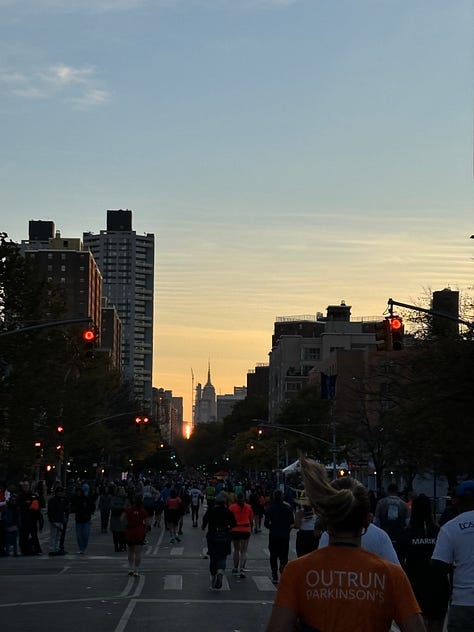
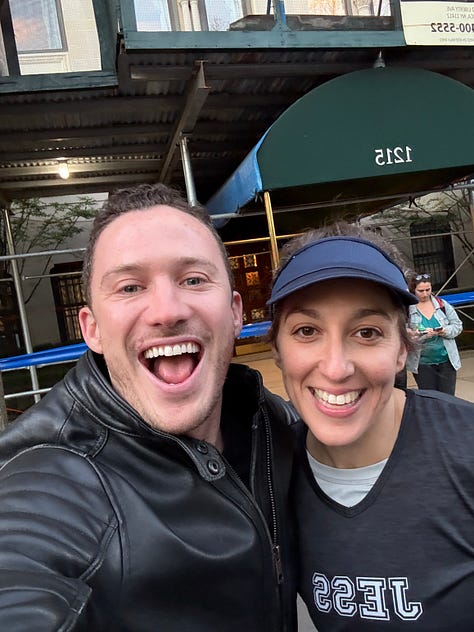
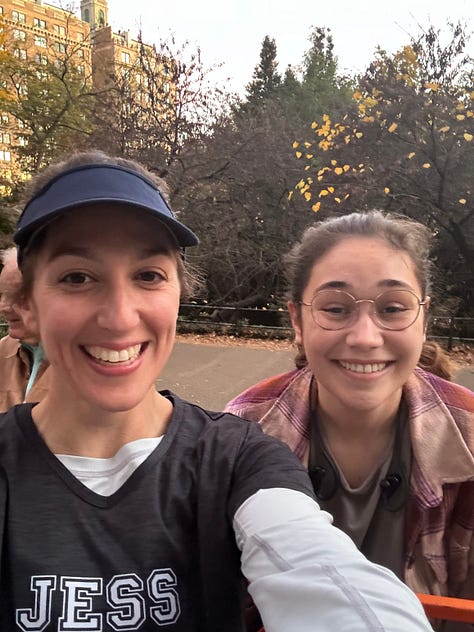
And then, when we were running on fumes, desperately stumbling toward the finish line, something incredible happened.
Some background context: While we waited in line for the bus to Staten Island in the morning, we chatted with a woman named Kristy and her husband Chris. We said our good byes and good lucks when we entered the Start Village, without exchanging last names and assuming we’d never see each other again.
You can probably see where this part of the story is going: Just past mile 25, Kristy jogged up beside us. We were equally incredulous to have found ourselves in the same place at the same time nine hours after parting ways. I shared with Kristy that we were pushing for Amanda’s PR, so she decided to stick with us to the end. The chance encounter provided us the last bit of adrenaline needed to make it to the finish, and somehow the three of us crossed the finish line at the exact same time, down to the hundredth of a second!
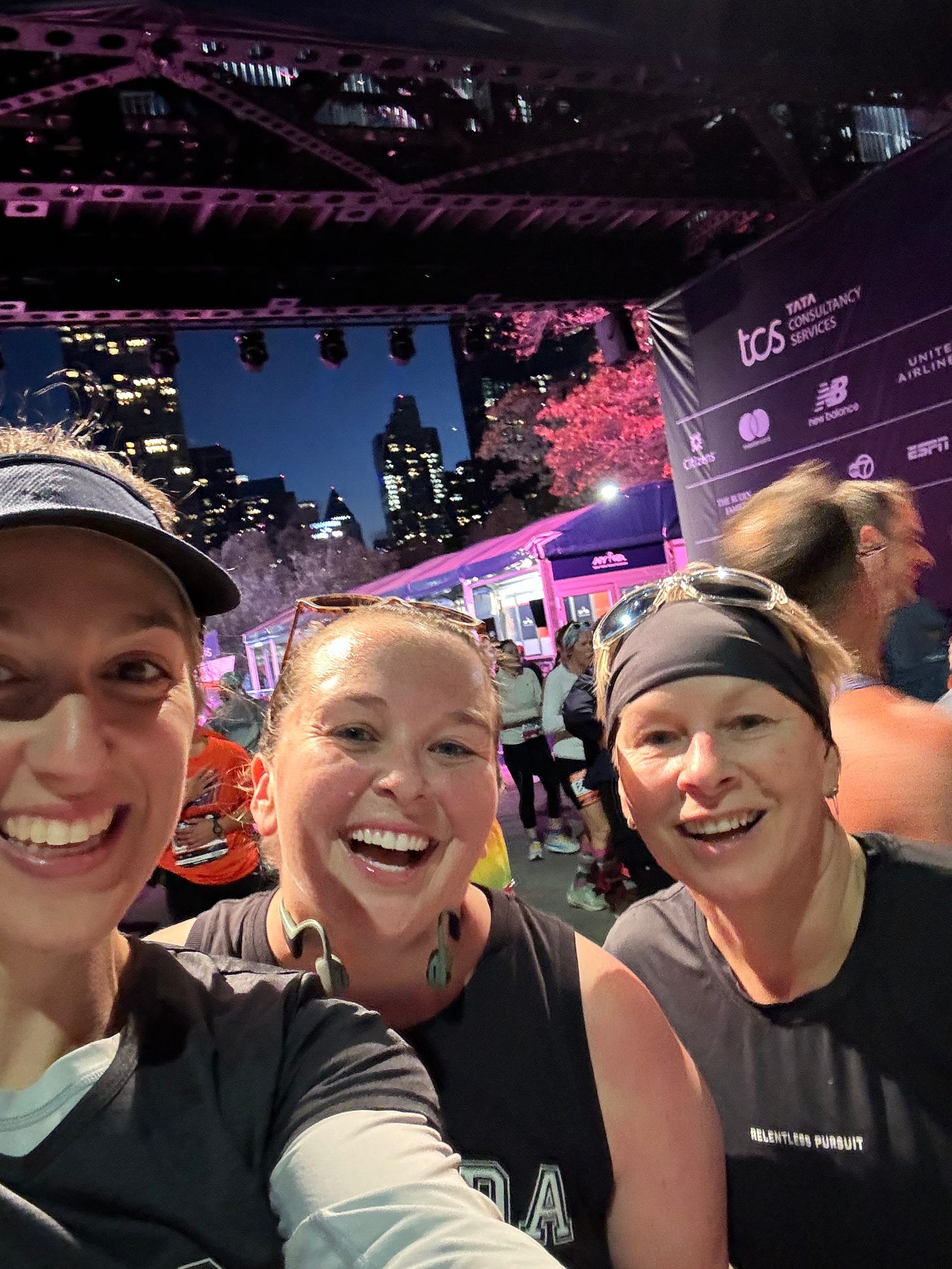
Post-Race
A few yards after crossing the finish line, one of the 10,000 volunteers drapes the shockingly weighty medal around your neck. Another few yards later, a volunteer wraps you up in the signature poncho (a significant upgrade from the space blanket we were given after the Chicago Marathon!), and another hands you a bag of snacks and beverages. Like sheep, the tired and delirious runners are then herded along a mile-long pathway to the exit.
By the time we made it out of the park, we were hungry, thirsty, and ready to take off our running shoes. But first, we had to schmooze with dozens of police officers to let us through the many barricades that were blocking the most direct route to our next destination, where my incredible friends Betsy and Andy volunteered to store our post-race necessities. We ventured to their home to change into warmer, cleaner, and drier clothes, and in true Jewish motherly fashion, Betsy had cold beverages and an assortment of snacks prepared upon our arrival. While Amanda was coordinating our dinner plans with her family, I might have convinced Andy that he should run the marathon with me next year.
We ended the evening trying to reverse our calorie deficit at a delicious Italian restaurant before hobbling back to our hotel to shower and sleep. Why do the happiest days always go so fast? Somehow, the daunting and seemingly insurmountable endeavor we were weary of the night before had already become a collection of distant memories waiting to be recalled.
Medal Monday
If you ever choose to run one of the World Major Marathons, be sure to allow yourself time to stick around the city the day after. Medal Monday is a fun (and mildly embarrassing) tradition where runners don their medal around their necks while out and about in search of freebies for their accomplishment8.
Amanda and Eddie went out to Long Island to see her (almost 101-year-old!) grandpa Monday morning, so I spent most of the day visiting friends in Brooklyn and Manhattan and walking around the city in a feeble attempt to stave off the inevitable soreness of my exhausted leg muscles.
It felt weird to wear the medal, in part because it’s actually really heavy9, but also because I’m uncomfortable drawing attention to myself in public. Each time I stepped foot on a crowded train someone stood up to offer me their seat, complete strangers yelled their congratulations (sometimes from across the street), and fellow finishers stopped me to take advantage of the opportunity to swap stories with someone who gets it.
These interactions are the only* instances where “Was this your first time?” is an appropriate question.
It was indeed my first NYC Marathon, but it certainly won’t be my last.
Also eyeing the 2026 London Marathon, with Boston and Tokyo between 2027 and 2030, rounding out my goal of earning the six-star World Majors medal before I turn 40
Fortunately, the NYC Marathon is always the same Sunday that Daylight Saving Time ends, so the extra hour of sleep helped balance out our jet lag.
By 8 am, an hour before the official start time, and long before most ferry riders make it to the village, most of the porta potties were out of toilet paper. Pro tip: always bring toilet paper in your running pack, you never know when that Imodium might fail.
I saw him a few more times throughout the race. On each sign, the percentage of the loading bar was filled in further, labeled with the same impressively specific distance completed at each viewing.
I didn’t realize nostalgia could hit so hard so soon after the initial experience
Can officially confirm: Marathon Sunday is the happiest I’ve ever seen that city.
“That’s what she said?” — Michael Scott
Some of the perks for finishing the NYC Marathon include a Shake Shack burger, a cookie from Levain Bakery, a cupcake from Magnolia Bakery, a bowl of pasta from Ai Fiori, a coffee from Marathon Coffee, medal engraving at various athletic stores (and in Central Park for a fee), and free admission to the MOMA, EDGE, and Vessel (and discounted admission to several other museums and a handful of Broadway shows) *Note: Some freebies are only available the day of the race, which rarely works out for slower runners who have a later start and a much later finish.
It actually left a half-circle shaped bruise on my stomach where it was bouncing around all day!





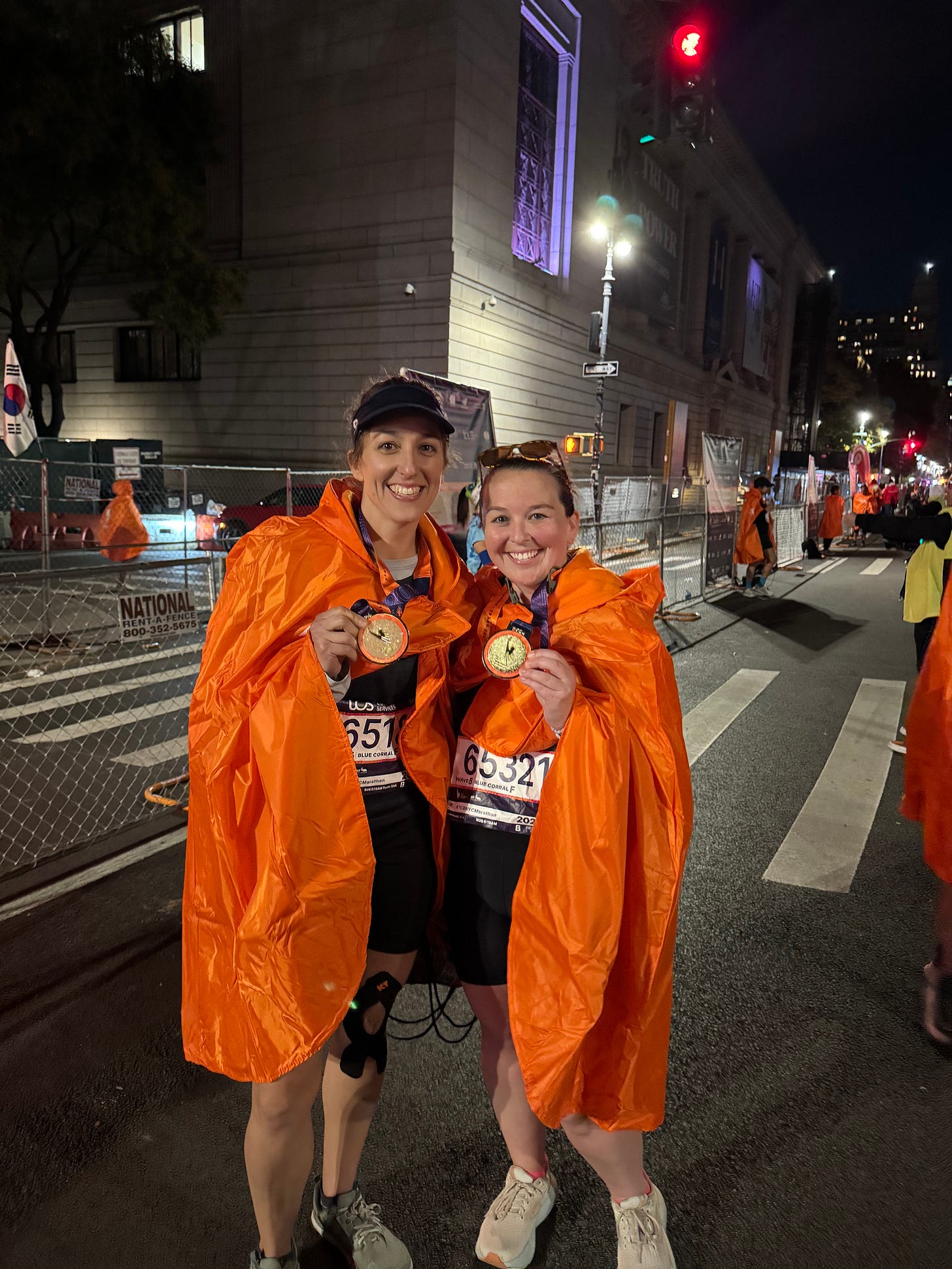
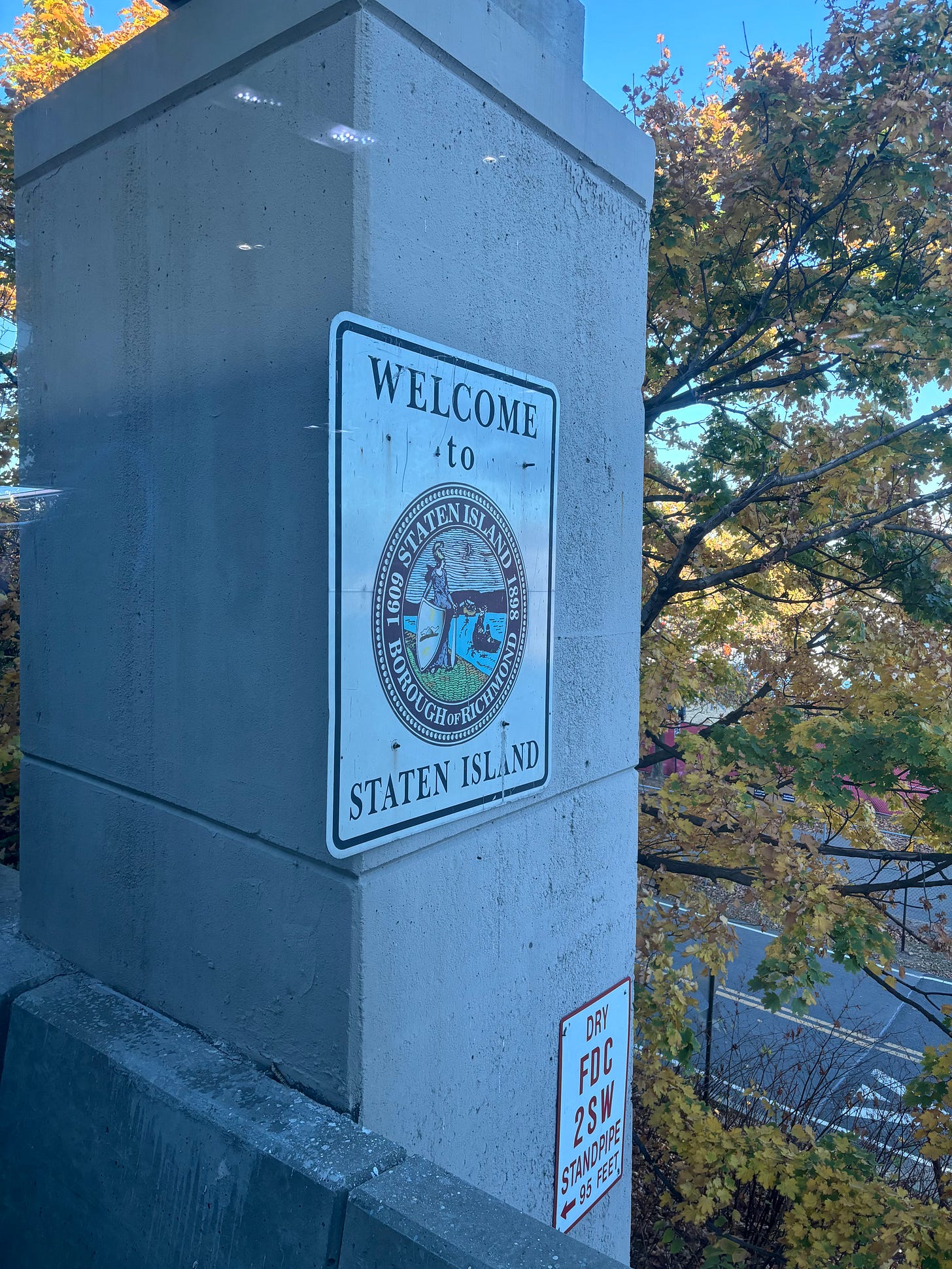

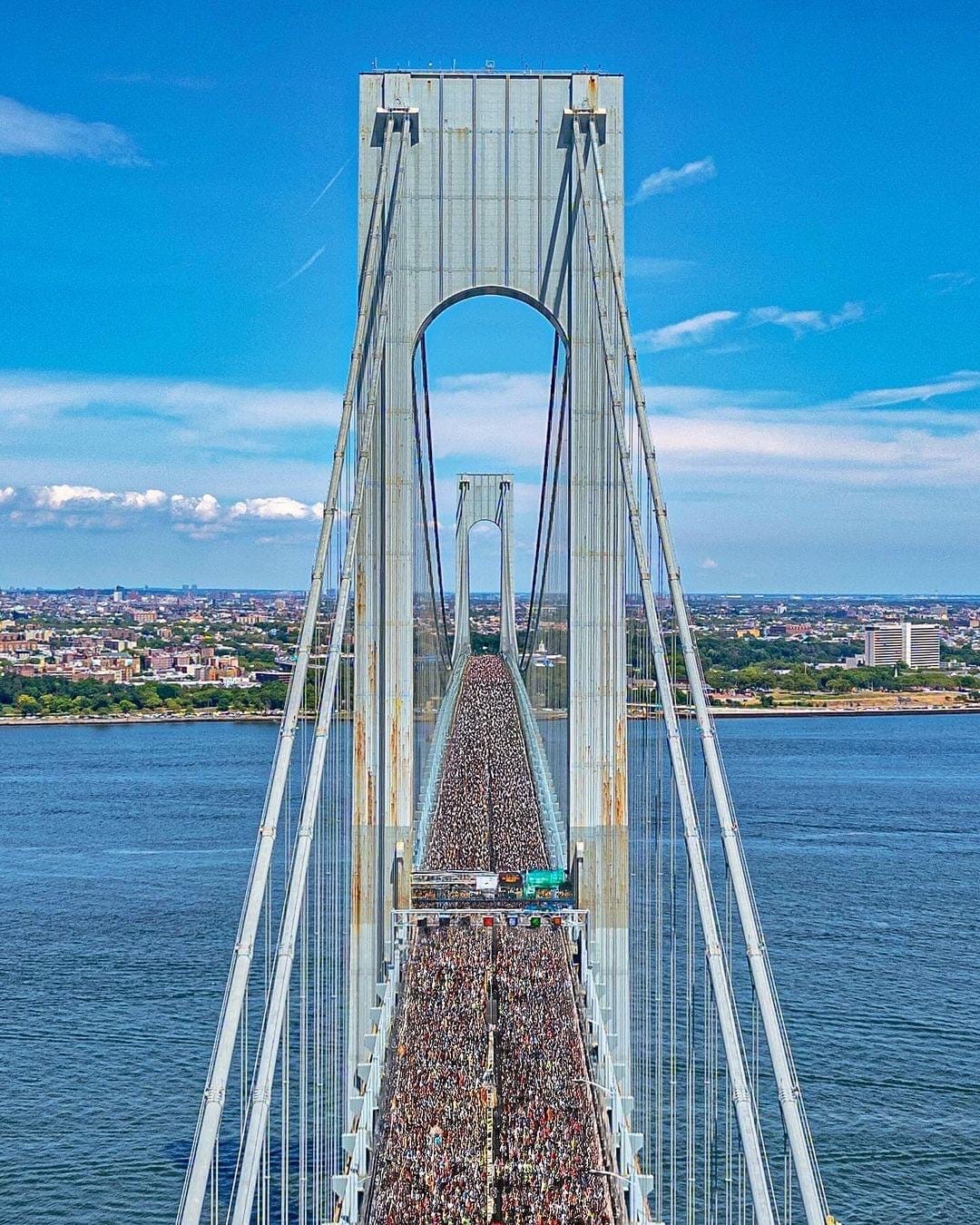
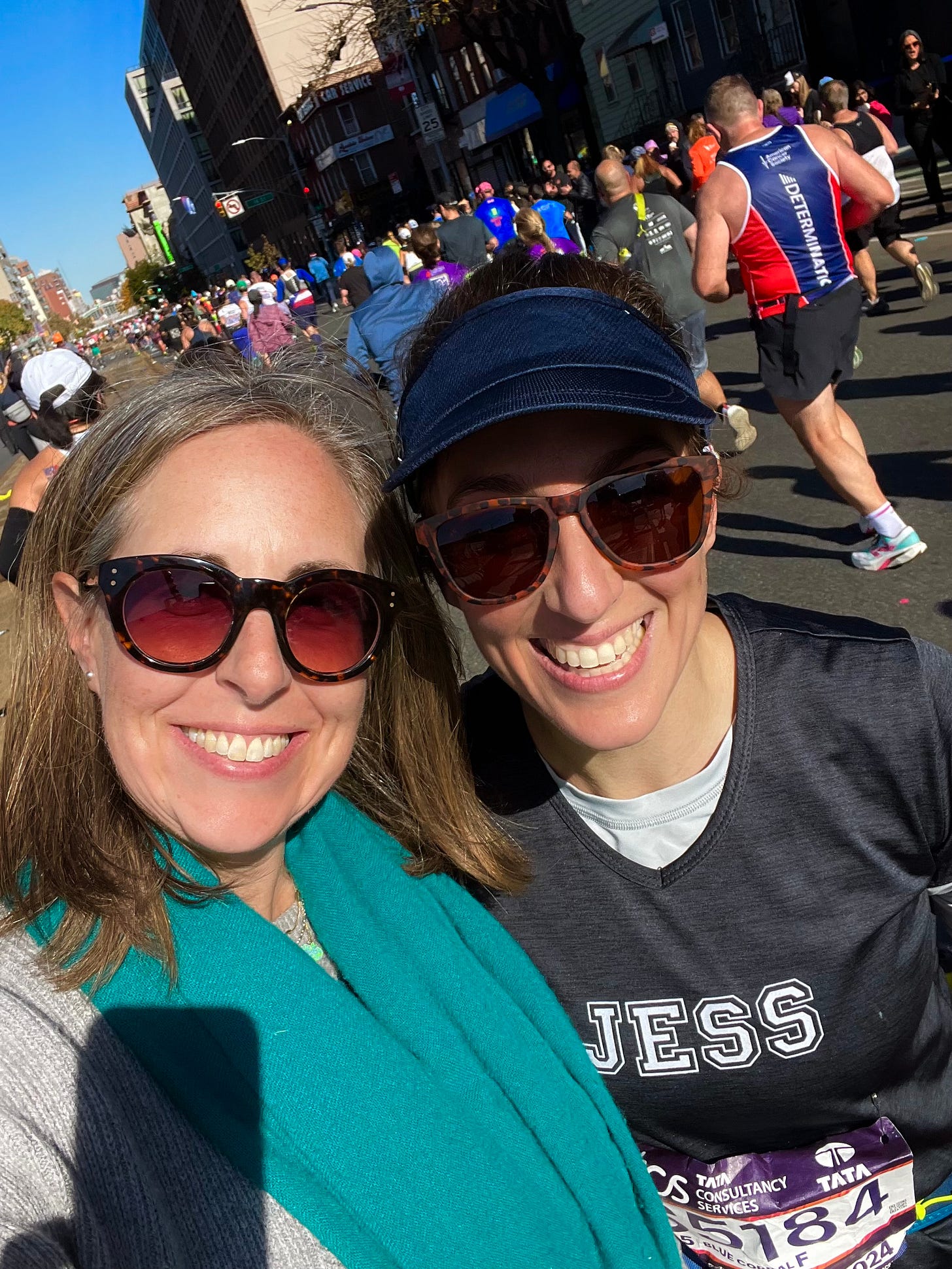
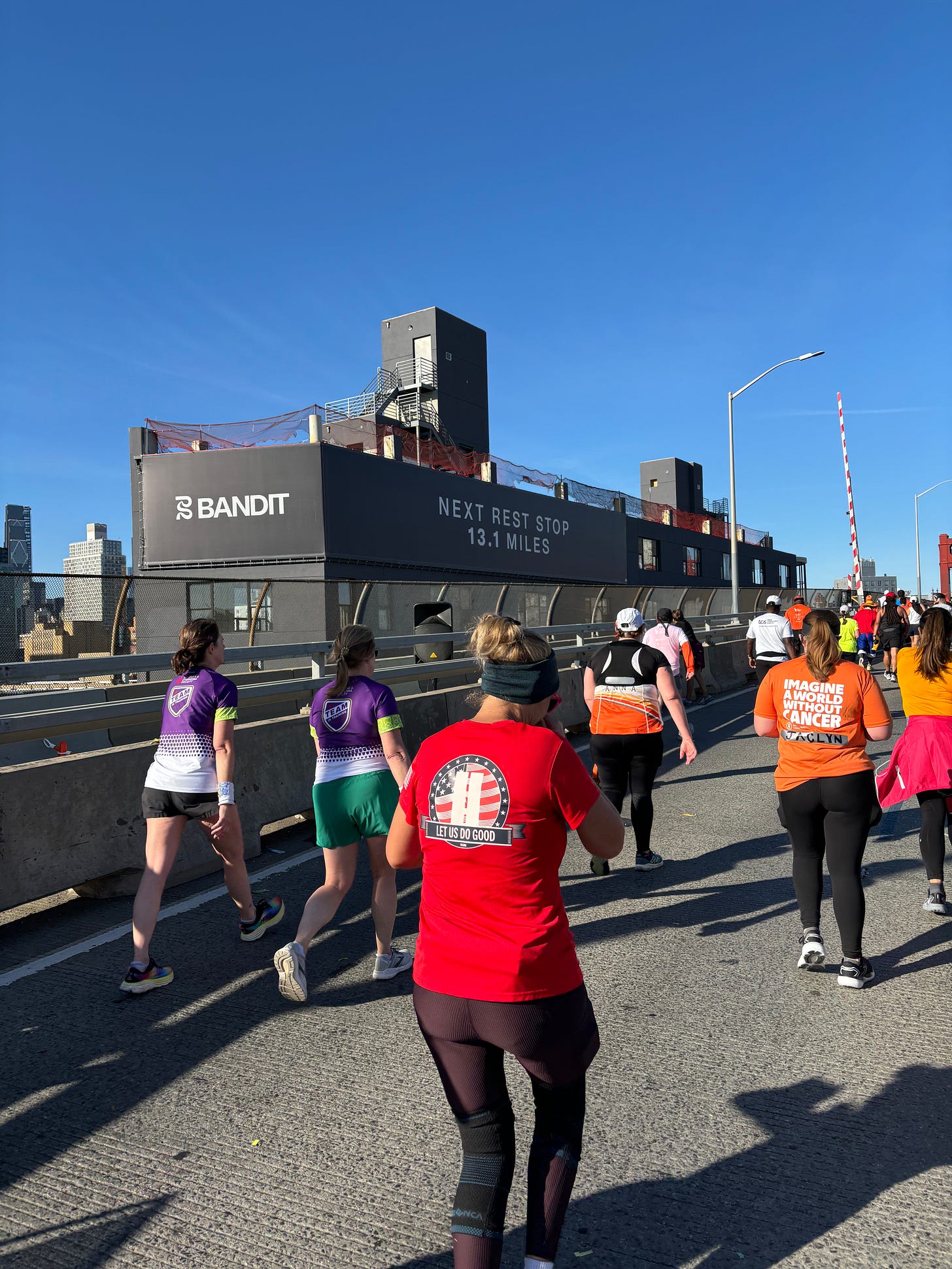
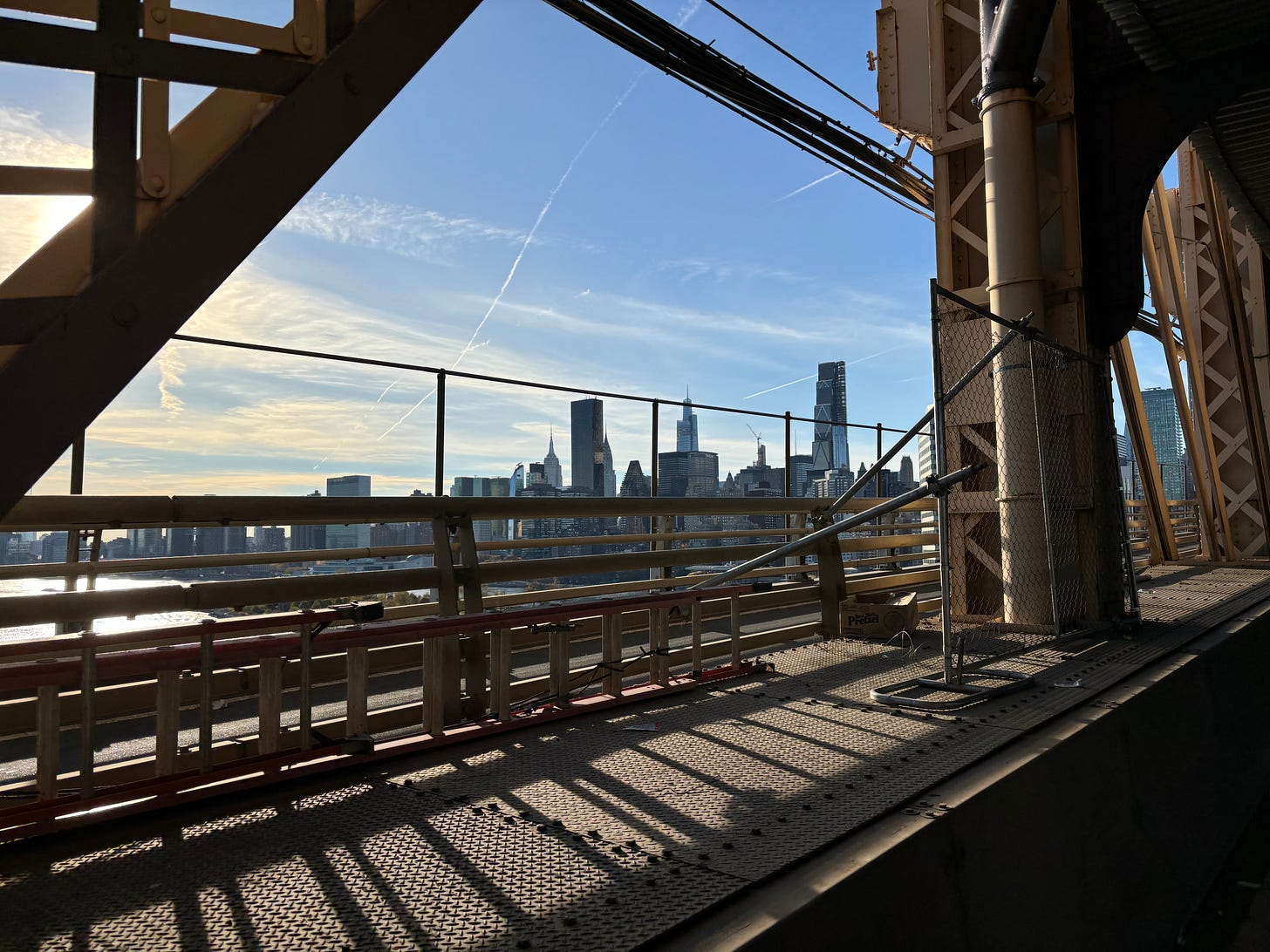
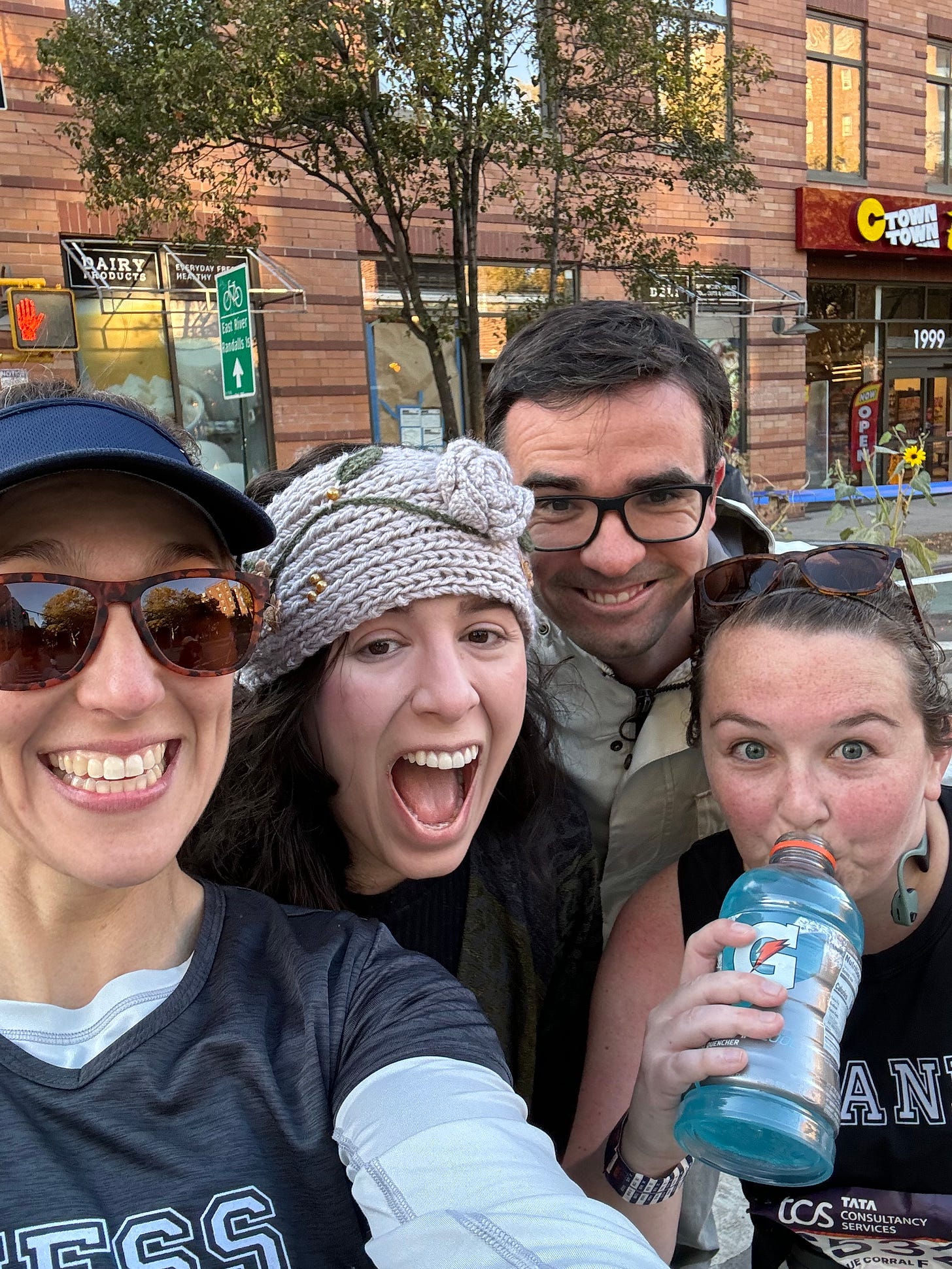
This was a great read and it sounds like a great race. I loved hearing about your nostalgia while running. I can’t say I ever felt nostalgia during any races, but I feel it very strongly when I ride or run on an old training route.
i loved the detail of this!! so interesting! and congratulations!!